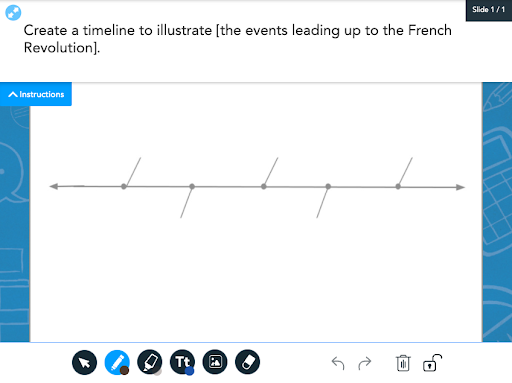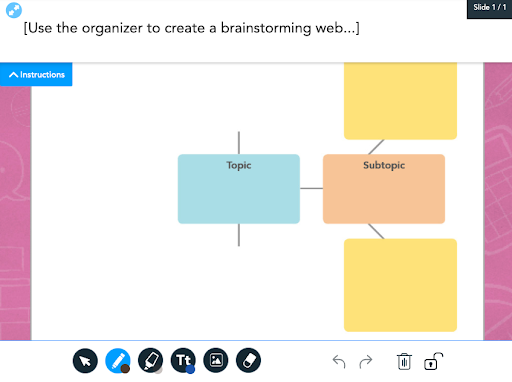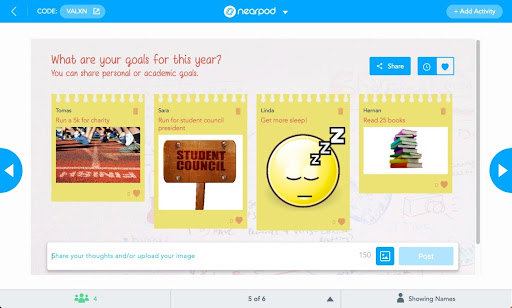
Using tech to encourage student written expressions
Student writing provides us with a window into their thinking, allowing educators to better understand a student’s depth of knowledge on a topic or identify misconceptions. Technology provides a range of opportunities for teachers to incorporate student written expression into their lessons, allowing teachers to easily incorporate writing across the curriculum, regardless of grade level. Digital tools, such as Nearpod, can help educators add variety to writing opportunities and support the differing needs of students.
Some benefits that technology can provide with student written expression include:
- Speech to text features, such as those offered by Google Docs and Microsoft, that turn student speech into writing to support those who may struggle with fine motor skills or writing disabilities.
- Text to speech features, such as Microsoft’s Immersive Reader, which reads text aloud and provides translation, among other features.
- Proofreading tools that can benefit students who struggle with writing skills including spelling, grammar, and sentence structure.
Several of Nearpod’s formative assessment activities support written expression in the classroom. Let’s zoom in on three in particular: Draw It, Open-Ended Question, and Collaborate. These activities are open-ended in nature, allowing students to demonstrate their learning beyond a single right or wrong answer. They allow teachers to assess communication, conceptual understanding, and thinking skills. Each of these activities have options that allow teachers to easily scaffold the learning and differentiate to meet a variety of learner needs. Let’s take a look at how each activity supports student writing in more detail.
1. Draw It
Draw It is one of Nearpod’s most popular and versatile activities, giving students the option of expressing their thoughts using text, images, annotation, and highlighting. A Draw It slide can be as simple as a plain white background, allowing students to freely express their thoughts, or teachers can upload a background image or select from Nearpod’s activity library to help students organize their writing.
Draw It offers teachers the ability to share written student expressions anonymously to the class, furthering the learning of the entire class by generating discussion around a student’s writing to provide feedback, make improvements, etc.
Here are some ideas of how you can use Draw It to encourage student writing across the curriculum:
- ELA
- Upload a selection of text on the slide background and have student’s highlight the text and write notes to show text evidence of a specific skill.
- Incorporate Draw It into the prewriting process with backgrounds such as a brainstorming web or essay planner.
- Upload a PDF as reference media and invite students to reflect on reading selections with open-ended prompts or questions.
- Math
- Use a blank Draw It slide and have students show the steps they took to solve a math problem
- Ask students to use words and/or pictures to explain how they solved a math problem.
- Science
- Have students compare and contrast two scientific concepts using a Venn Diagram.
- Use this template to have students explain the parts of the scientific method during an investigation.
- Social Studies
- Incorporate timelines to have students write about historical events.
- Include a historical primary source on background and have student annotate and reflect using the text and highlighter tools.
Utilize a cause-effect graphic organizers to think critically about social studies topics.
2. Open-Ended Questions
Another Nearpod activity that encourages student written expression is the Open-Ended Question (OEQ). This activity is a great way to encourage reasoning and critical thinking skills. You can provide students with the audio recording option to support different learning needs, such as those who are emerging writers or EL students. Similar to Draw It, teachers have the option of sharing student responses to the class to further the learning. You can easily differentiate the question options using the reference media to provide differing levels of questions that students can select from based on their individual needs, such as this example from one of Nearpod’s Historical Perspective and Literacy (HPL) lessons.
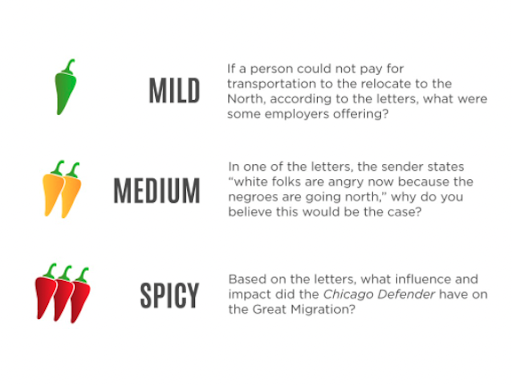
There are many ways to use the OEQ to support student writing across the curriculum, including embedding them into interactive videos to have students reflect on content being presented or using an OEQ at the end of a lesson to summarize learning as an exit ticket. Here are some additional subject specific examples of how Open-Ended Questions can be used to support writing instruction.
- ELA
- Make connections to text (Text to Self, Text to Text, Text to World).
- Respond to text dependent questions by uploading a PDF text selection as reference media.
- Math
- Use an OEQ as a follow-up to solving a math problem to have students use words to explain how they solved it.
- Use reference media to show a chart/graph and ask students to share one or more conclusions they can draw from the information.
- Science
- Use OEQs as part of the Claim, Evidence, Reasoning (CER) model
- Social Studies
- Link a news article or primary source as reference media and have students reflect on an open ended prompt.
- Reflect on implications of historical events.
2. Collaborate Board
A third great way to encourage student writing in Nearpod is using a Collaborate Board activity. This activity gives students the option to respond to prompts or open-ended questions using text and images. Students are able to anonymously see the responses of their classmates on a virtual corkboard, making this a great way to give every student a voice before group discussions. The Collaborate Board activity is a great way to provide a shared space where students can learn from each other’s written responses and interact with the responses of other students.
Looking for ways to incorporate written expressions using Collaborate Boards? They can be used across the curriculum in several ways:
- Use a single Collaborate board as a parking lot for student questions throughout a lesson.
- Have students define or use new vocabulary words in a sentence to show understanding.
- Use as a prior knowledge check at the start of a unit or lesson by having students share what they already know about a topic.
- Use a Collaborate Board as a follow-up to a poll question. Have students defend their answer choice from the poll and use the Collaborate as a springboard for classroom debate.
And here are some subject specific ideas for student writing:
- ELA
- Asking and answering questions related to a shared text.
- Math
- Sharing examples of math in the real world using text or images to help students make connections beyond the classroom.
- Asking and answering questions as part of a math talk conversation.
- Science
- Making written observations during a science investigation on a shared space
- Social Studies
- Have students reflect on why historical events may have happened or what the effects of specific events were. This can be used to facilitate further discussion.
4. Immersive Reader
With the strong connection between reading and writing skills, Nearpod’s integration with Microsoft Immersive Reader provides an extra level of support for student writing.
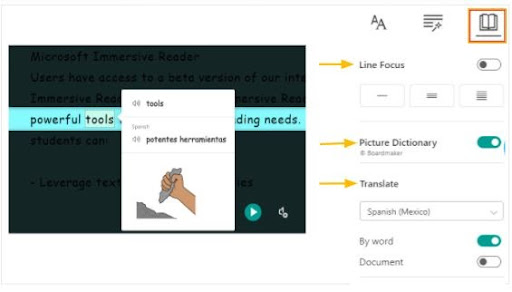
With the Immersive Reader tool, students can access text-to-speech, a picture dictionary, visual supports, and translation features to create a more supportive classroom environment for students who need reading assistance. This can allow students to focus more deeply on the content being taught and leave more energy for written expression to lesson prompts.
Finding creative ways to incorporate student writing into the classroom provides teachers with an opportunity to make student thinking visible. This can help teachers identify and correct misconceptions or lead to deeper conversations around academic content. Using digital tools like Nearpod can provide learners with even more ways to showcase their thoughts in writing, helping to unlock student voice for all learners in your classroom. How have you used Nearpod to support written expression with your learners?

Kim is a former elementary school teacher who loves helping educators create authentic, student-centered learning experiences. She is driven by a desire to help students connect with others – within the classroom walls and beyond.

